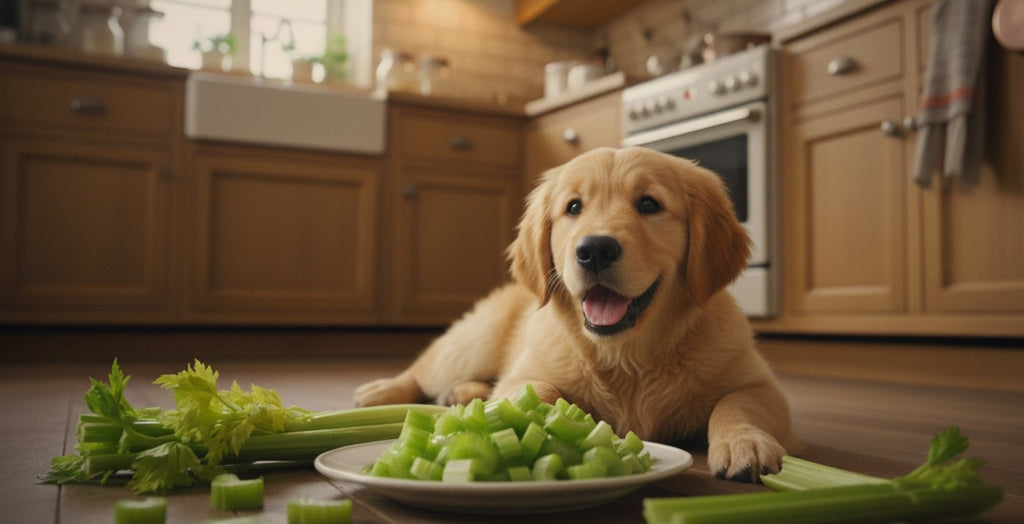Can Dogs Eat Broccoli? Vet-Reviewed Safety, Nutritional Benefits & Feeding Guide

Yes, dogs can eat broccoli, whether it's cooked or straight from your garden, because broccoli is high in fiber and vitamin C and low in fat. Broccoli is generally safe for dogs to eat, but raw broccoli and stalks can be a particularly difficult treat for dogs to digest so should be chopped.
But, if fed in moderation, chopped broccoli is a safe, tasty treat for our canine friends, both raw and cooked. The key is knowing how much to offer, how to prepare it, and when it might be better to skip it altogether.
Nutritional Benefits of Broccoli for Dogs
Broccoli is a low-fat, fibre-rich vegetable that offers more than just crunch. This green veggie provides vitamins and antioxidants that support everyday health, with specific nutrients playing different roles in digestion, immunity, and joint comfort. It is part of the ‘cruciferous’ vegetable family, which includes broccoli, cabbage, kale, cauliflower, and bok choy.
The best way to understand broccoli’s role in your dog’s diet is to explore its key nutrients, the health benefits they offer, and how it measures up to other vegetables.

Micronutrients in Broccoli That Support Overall Dog Wellness
Broccoli contains several key micronutrients that help maintain and improve your dog’s health:
-
Vitamin C: An antioxidant that may support immunity and reduce inflammation. Dogs make some vitamin C themselves, but extra amounts can benefit older or stressed dogs.
-
Vitamin K: Helps blood clot normally and supports bone health.
- Folate (Vitamin B9): Aids cell growth and red blood cell production, which is important for pregnant dogs and those recovering from illness.
How Broccoli Nutrients Improve Digestion, Immunity & Joints
The nutrients in broccoli can play roles in three areas of health:
-
Digestion: Fibre helps regulate bowel movements and supports healthy gut bacteria.
-
Immunity: Antioxidants and polyphenols reduce the impact of free radicals that damage cells, an anti-cancer effect.
- Joint Health: Natural compounds like glucosinolates may help ease inflammation linked to stiffness or pain in some dogs.
How Broccoli Compares to Other Dog-Safe Vegetables
While broccoli offers fibre, vitamins, and antioxidants, other vegetables provide different benefits. The table below compares broccoli with other dog-safe vegetables, such as carrots, green beans, and pumpkin, in terms of fibre, nutrients, digestibility, and best uses.
|
Feature |
Broccoli |
Carrots |
Green Beans |
Pumpkin |
| Fibre Content | Moderate (2.6%) | Low-moderate | Low | Moderate to high (mainly soluble) |
| Key Nutrients | Vitamin C, K, folate, antioxidants | Beta-carotene (Vit A), potassium | Vitamin K, manganese, folate, vitamin C | Fibre, Vit A, potassium |
| Digestibility | Can cause gas if overfed | Easy to digest, low gas | Gentle on the gut, less nutrient-dense | Very digestible, good for sensitive stomachs |
| Great For | Immune support, antioxidant boost, fibre variety | Eye health, skin support, dental-friendly chew | Weight control, low-cal filler | Soothing digestion, easing loose stools or constipation |
Cooking methods can alter digestibility and nutrient availability, with cooked vegetables being generally easier to digest.
Can Dogs Digest Broccoli Easily? Understanding Canine Digestive Compatibility

Broccoli is safe for most dogs, but the way their gut handles it makes all the difference. Only offer the stalk if it has been chopped up into small pieces. The issue isn’t toxicity; it’s digestibility. Some dogs can manage a few florets without trouble, while others may feel bloated, gassy, or uncomfortable if they get too much at once.
The way broccoli moves through your dog’s gut, the fibre it contains, and your dog’s own health all determine whether it’s easy to digest or not.
How a Dog's Digestive System Processes Broccoli
A dog’s digestive system is built differently from ours. Their shorter gut leaves less time to break down fibrous foods like broccoli. On average, food passes through their digestive system in 8 to 10 hours.
Chewing does little for vegetables, since dogs produce very few salivary enzymes. Instead, most of the work happens later in the colon, where bacteria ferment undigested fibre. Because broccoli is a cruciferous vegetable, it produces more gas during this process than gentler options like pumpkin or carrots.
This is why too much broccoli at once can leave your dog feeling bloated or sore. Small, gradual servings are much easier on their system.
Fibre Content and Its Role in Canine Digestion
Broccoli is about 2.6% total fibre, which contains:
-
Soluble fibre that helps slow digestion, balances blood sugar, and feeds good gut bacteria.
- Insoluble fibre that adds bulk to stools and improves motility.
Most dogs do best with 2-5% fibre in their diet. In moderation, broccoli can help regulate bowel movements. But if you introduce too much insoluble fibre too quickly, you may notice diarrhoea, softer stools, or mild cramping. For this reason, broccoli should stay a supplement, not a staple food.
Why Some Dogs Tolerate Broccoli Better Than Others

Not every dog reacts the same to broccoli. Several factors affect how well your dog can tolerate it:
- Breed & size: Smaller dogs and brachycephalic (flat-faced) breeds often have more sensitive digestion.
- Age: Puppies and senior dogs process fibre less efficiently.
- Gut health: Dogs with colitis, IBS, or other gut conditions may struggle with cruciferous vegetables.
- Diet history: Dogs not used to high-fibre foods may need extra time to adapt.
If your dog shows signs of gas, bloating, or loose stools, scale back portions or try offering broccoli in a cooked, softer form.
How to Prepare and Feed Broccoli to Dogs Safely
The way you serve broccoli can be the difference between a healthy snack and a sore stomach. Cooking methods like steaming or boiling change how easy it is to digest, while portion size depends on your dog’s weight. Once it’s prepared properly, broccoli works best in small amounts alongside their regular meals.
Best Ways to Prepare Broccoli for Dogs
Preparation directly influences how well dogs digest broccoli and how many nutrients they absorb. Chopping the hard stem into smaller pieces will reduce the risk of choking. Steaming softens the vegetable, including the stem, without stripping its goodness, boiling makes it easier to chew but reduces water-soluble vitamins, while raw pieces keep all nutrients intact but increase the risk of choking.
|
Method |
Suitability |
Benefits |
Risks |
| Steamed | Best option | Gentle on digestion, preserves most nutrients, safer texture | Over-steaming lowers vitamin content |
| Boiled | Acceptable | Softens broccoli, retains fibre | Water-soluble vitamins lost to boiling water |
| Raw | Occasional | Retains nutrients, crunchy for enrichment | Harder to digest, choking risk if not cut small |
To reduce the choking risk when fed raw, always chop broccoli into pea-sized pieces for toy and small breeds, and bite-sized florets for medium to large dogs. The stem can be fed but only chopped up. This ensures safer chewing and easier swallowing.
Portion Size Guidelines Based on Dog Weight
Broccoli should never make up more than 10% of daily calories. Portion sizes vary with body weight, and smaller breeds are more sensitive to excess fibre.
|
Dog Weight |
Safe Daily Portion |
| Under 5 kg | ½-1 small floret |
| 5-10 kg | 1-2 small florets |
| 10-20 kg | 2-3 small florets |
| 20-30 kg | 3-4 small florets |
| 30 kg+ | Up to ½ cup chopped broccoli |
If you are introducing broccoli to your dog for the first time, begin with half these amounts and monitor stool and behaviour. Even once tolerated, broccoli should only be offered 1-2 times per week, not daily, to avoid fibre overload or digestive discomfort.
For puppies under six months, broccoli is best avoided altogether, as their immature digestive systems cannot process fibre efficiently and may react with bloating or diarrhoea.
How to Add Broccoli to Dog Meals Safely

In canine nutrition, broccoli works best in moderation as a topper or treat. It cannot replace a complete, balanced diet. The best approach is to prepare it plainly and add it in small amounts to meals or use it as a treat. Practical ways include:
-
Mixed with kibble: Steam and chop broccoli, then stir a few small pieces through dry food for a nutrient boost.
-
Mashed into wet food: Ideal for seniors or dogs with dental issues, since it’s softer and easier to digest.
-
Served frozen: Freeze steamed pieces for a cooling summer snack that also provides hydration and enrichment.
-
Rotated with other vegetables: Alternate broccoli with options like pumpkin or carrot to prevent nutrient overload and keep meals varied. For enrichment, broccoli can also be used creatively. Frozen florets work as a cooling chew, or mashed broccoli can be stuffed into a Kong toy for a low-calorie boredom buster.
|
Example 1: Steamed broccoli + Lean kangaroo mince Mix a handful of finely chopped, steamed broccoli into a meal of lean, cooked kangaroo and a small amount of sweet potato. Example 2: Steamed Broccoli + Grain-free kibble Chop up a few steamed florets and mix them into your dog’s regular grain-free kibble. Add a drizzle of flaxseed oil for better vitamin absorption. This way, broccoli becomes a healthy add-on, not a replacement. |
Broccoli Risks for Dogs: Compounds, Tolerances & Breeds
Even though broccoli is a cracking healthy treat, it's not without its risks, and those risks aren't a one-size-fits-all thing. The potential for a bad reaction depends on 3 main things: plant compounds, dog breed, and gut tolerance.
Harmful Compounds in Broccoli for Dogs

Broccoli itself isn’t toxic, but it does contain natural plant chemicals called isothiocyanates. In small amounts, these may help reduce inflammation, but excessive consumption can upset the gut and trigger gas, diarrhea, or discomfort.
If broccoli makes up more than 25% of a dog’s daily calories, these compounds may reach toxic levels, so it should only ever be served as a small side treat. Steaming broccoli softens fibre and lowers the effect of these compounds, making it easier to digest.
Preparation can also introduce additional dangers. Seasonings like garlic and onion, often used in stir-fries, are highly toxic to dogs. Even trace amounts cooked into broccoli can damage red blood cells over time.
Other common add-ons, such as soy sauce, stock cubes, chilli flakes, or rich oils, are also unsuitable because they raise salt, fat, or spice levels beyond what a dog’s gut can safely handle. Broccoli should only ever be served plain.
Dog Breeds Prone to Broccoli Intolerance
Some dogs are more likely to struggle with broccoli because of their size, gut sensitivity, or chewing ability. Breeds commonly affected include:
-
Toy and small breeds (Chihuahuas, Maltese, Mini Dachshunds): Smaller digestive capacity makes them less tolerant of extra fibre.
-
Brachycephalic breeds (Bulldogs, Pugs, Boxers): Flat faces affect chewing, so large chunks may reach the stomach undigested.
- Sensitive-gut breeds (German Shepherds, Greyhounds): Prone to IBS or food sensitivities, which broccoli fibre can worsen.
Symptoms of Broccoli Sensitivity in Dogs
Dogs that don’t tolerate broccoli usually show signs within a few hours of eating. Watch for:
- Excessive gas or bloating
- Vomiting or repeated attempts to vomit
- Soft stools or diarrhoea
- Itching or mild skin irritation
- Refusal to eat or reduced appetite
When to Consult a Vet Before Feeding Broccoli
Certain health conditions make broccoli a higher-risk food. Speak to your vet first if your dog has:
-
Hypothyroidism: A hormonal disorder where goitrogens in large volumes of raw broccoli should be monitored in dogs with abnormal thyroid function.
-
IBD: Chronic digestive issues often aggravated by cruciferous vegetables.
- Medication reliance: Some drugs require steady absorption, which fibre may disrupt.
Even for healthy dogs, changes in stool, loss of appetite, or discomfort after eating broccoli signal that it’s time to pause and consult with your veterinarian.
Dog-Safe Alternatives for Broccoli Haters

Some dogs simply don’t take to broccoli, and that’s okay. What matters most is finding vegetables that are gentle on the stomach while still delivering fibre, vitamins, and antioxidants. Luckily, there are several safe options that often win dogs over.
-
Carrots: A crunchy favourite that doubles as a dental chew. Rich in Vitamin A and beta-carotene, carrots support eye health and skin repair while being naturally low in calories.
-
Pumpkin: Packed with soluble fibre, pumpkin soothes sensitive tummies, firms up loose stools, and helps regulate digestion.
- Green beans: Low in calories but high in fibre, green beans make a filling snack for dogs that need help with weight management.
Rotating these vegetables can keep meals interesting, improve gut health, and reduce the risk of overloading your dog with one single fibre source. If your dog isn’t keen on broccoli, these alternatives can step in to provide many of the same nutritional benefits.
Petzyo’s Whole Food Nutrition Approach for Dogs
Feeding your dog doesn’t need to be complicated. At Petzyo, we design every meal around whole, real ingredients, including dog-safe vegetables like broccoli, to make balanced feeding simple and stress-free for pet parents.
Explore Petzyo’s most popular whole-food meals below, each crafted with premium proteins and vegetables.
Why Petzyo Includes Whole Vegetables in Dog Meals
We believe dogs benefit most when nutrition comes from natural sources. That’s why we use whole vegetables and fruits in every premium dog food recipe. They provide fibre to support digestion, antioxidants to strengthen immunity, and essential vitamins for long-term wellbeing.
Broccoli is one of these vegetables, carefully portioned alongside carrots and pumpkin, so dogs get the benefits without the risks of overfeeding. Each ingredient is carefully selected for its specific function, rather than being used as a cheap filler.
How Petzyo Helps With Balanced Feeding
Feeding the right amount of vegetables isn’t always straightforward, especially when you are managing a dog’s weight, age, or sensitivities. Our meals take care of this balance by combining:
-
Animal proteins for strength and sustained energy.
-
Vegetables for natural vitamins, minerals, and gut support.
- Superfoods like flaxseed and turmeric for joint, skin, and immune health.
Every recipe is formulated by board-certified veterinary nutritionists, approved by vets. This way, you don’t need to worry about portioning broccoli, pumpkin, or carrots on your own. Petzyo ensures every bowl is complete, balanced, and Aussie-made.
FAQs About Feeding Broccoli to Dogs

Is It Safe to Feed Broccoli to Dogs Every Day?
No, it is not safe to feed broccoli to dogs every day. Broccoli is safe only in small amounts and in moderation (1-2 times per week) to prevent bloating, gas, or diarrhoea from its fibre and compounds.
Is Frozen Broccoli Safe for Dogs?
Yes, frozen broccoli is safe for dogs when plain and served thawed or lightly steamed. Frozen broccoli should always be cut into small pieces to avoid choking, especially for toy or small breeds.
Are Broccoli Stems and Leaves Safe for Dogs?
Yes, broccoli stems and leaves are safe for dogs. Broccoli stems are fibrous, while broccoli leaves are nutrient-rich, but both should be chopped or cooked so dogs can chew and digest them safely and in moderation.
Is It Okay to Combine Broccoli and Cauliflower in a Dog’s Meal?
Yes, it is okay to combine broccoli and cauliflower in a dog’s meal occasionally. Broccoli and cauliflower share compounds and fibre, so keep portions small to avoid bloating and monitor your dog for digestive upset and gas.
Why Are Garlic and Onion Dangerous When Cooked With Broccoli?
Garlic and onion are dangerous when cooked with broccoli because they contain N-propyl disulfide. These compounds can damage red blood cells in dogs.
Can Dogs Eat Salted or Buttered Broccoli?
No, dogs should not eat salted or buttered broccoli. Salted broccoli won’t do too much harm, while buttered broccoli is high in fat and may trigger pancreatitis in susceptible dogs. Dogs should only eat plain broccoli without seasoning.
Final Guidance for Feeding Dogs Broccoli Safely
Broccoli can be a safe, fibre-rich treat for dogs when served plain, lightly steamed, and in small portions. Always watch how your dog responds, and speak with your vet first if they have sensitive digestion or diabetes.
For everyday balanced nutrition without the guesswork, choose Petzyo’s vet-approved, tailored meals made with whole vegetables and premium proteins. Start your dog on a tailored Petzyo plan today and make every bowl simple, healthy, and Australian-made.





